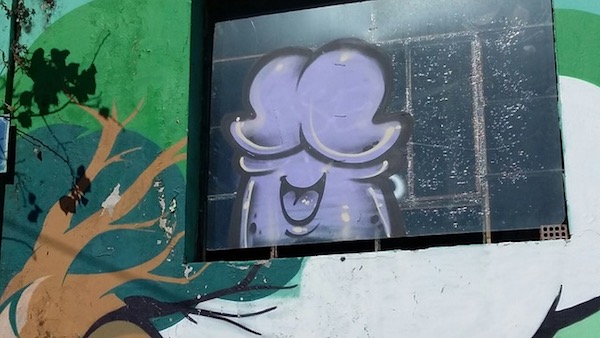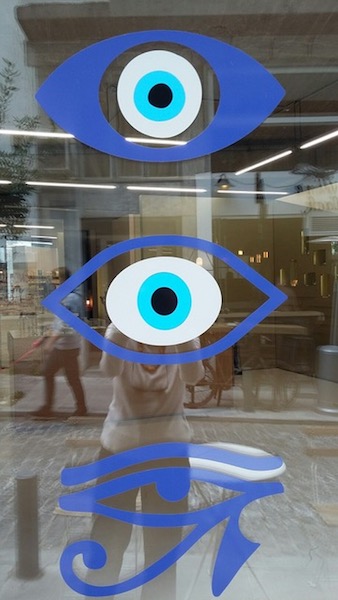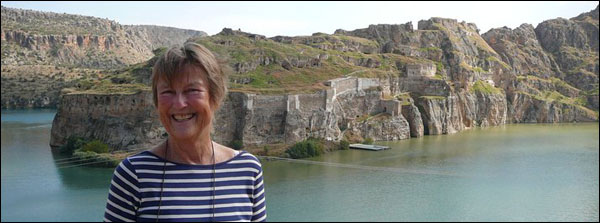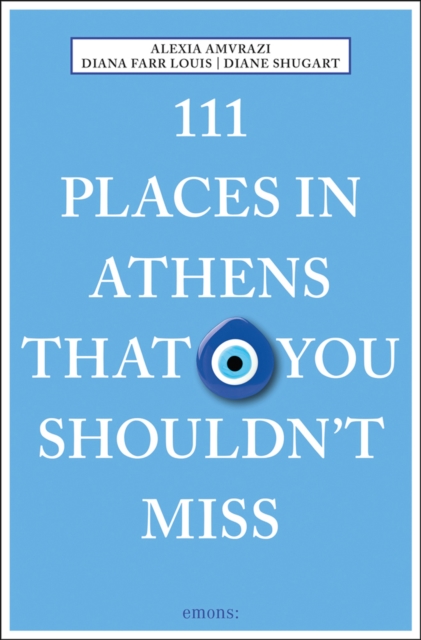Athens Is The New Athens (Revisited)
“This column, first published last May, was the result of several months spent exploring The Big Olive for a new book, 111 Places in Athens That You Shouldn’t Miss. I intended it as a teaser. Now the book has been released and so I’m hoping you’ll reread this and rush out to buy it, from your favorite bookshop, or online, if there’s no alternative. Even if you don’t live in Greece and have no intention of visiting, the book is perfect for armchair travelers, too. For it’s no ordinary guide book; it contains stories about places unknown even to native Athenians, and it may be viewed as a mosaic history of the city, from the remote past into the near future. Think of this column as but a tiny taste of what the book contains.”—Diana Farr Louis
Eating Well Is The Best Revenge
By Diana Farr Louis

Author’s Note: This column, first published last May, was the result of several months spent exploring The Big Olive for a new book, 111 Places in Athens That You Shouldn’t Miss (Emons Verlag GmbH, Germany; ISBN 978-3-7408-0377-3; Price $19.90 £12.99). I intended it as a teaser. Now the book has been released and so I’m hoping you’ll reread this and rush out to buy it, from your favorite bookshop, or online, if there’s no alternative. Even if you don’t live in Greece and have no intention of visiting, the book is perfect for armchair travelers, too. For it’s no ordinary guide book; it contains stories about places unknown even to native Athenians, and it may be viewed as a mosaic history of the city, from the remote past into the near future. Think of this column as but a tiny taste of what the book contains. And here I’d like to thank my co-authors, Alexia Amvrazi and Diane Shugart, and photographer Yiannis Varouhakis for making it such fun and introducing me to their secrets.
ATHENS Greece—(Weekly Hubris)—November 2018—Last spring and summer, when Athens hosted Documenta 14, the first city outside Germany to host this prestigious, Kassel-based art festival, enthusiastic (foreign) reviewers started proclaiming, “Athens is the new Berlin.”
“You’ve got that wrong,” Greeks retorted. “Athens is the new Athens.” Meaning that the city is indeed a cultural capital, but with its own distinct identity; and that, despite years now of deep economic depression, it is witnessing a resurgence of creativity in all sorts of sectors, from the visual and performing arts to the culinary—and, particularly, in the art of survival.
If you don’t go into the center, but tend to stay in your own neighborhood or suburb, you may be likely to believe all the negative stories you hear—about filth, violence, shuttered shops, beggars, junkies, etc.—and these certainly exist, but they are not the whole picture.
This winter, research for a new book took me out of my comfort zone in the garden suburb of Kifissia into Athens’ city center two or three times a week. My wanderings, from Kypseli to Psyrri, the Central Market district, Syntagma, Koukaki, Kerameikos, Thissio, and even the notorious anarchists’ den of Exarchia, revealed a city with some depressing features, of course, but which pulses with vitality, cheer, and kindness. Busy and lively day and night, with crowded restaurants and crowded streets, what I saw left me to wonder where the crisis was.
I know it hasn’t gone away. Our own income is a fraction of what it was even five years ago, and most of it goes to pay for taxes and basics, which don’t include central heating but continue to cover wine, even if only (decent) Chateau Cardboard. And although abandoned shops still have homeless people camped on their doorsteps, the cars on Athens’ streets seem larger and newer; the carts in supermarkets piled higher with groceries. That there is an underground economy may be taken for granted, but whatever is fueling the city’s resurgence remains a mystery to me.
My research started in December with a visit to Boroume’s offices near Monastiraki, where I always go when I need a dose of joy and positivity. This NGO, founded just seven years ago “to save lives by saving food” and to foster a sense of community between food donors, whether shops, eateries, or even large companies, and their recipients, always has good news to share. In 2017, for example, they “saved and offered a total of 7,469,435 portions of food, more than 20,450 portions per day” and rescued 1,340 kilos of fresh fruit and veg from 13 of the city’s farmers’ markets, a new venture carried out with the help of 263 volunteers.
But they also shared a restaurant address, a mageireio or slow-food home cookery which delivers delicious casseroles several days a week, even though it’s by no means close by. Their tip led me to Antonopoulos Traditional Cuisine Restaurant, near the National Archaeological Museum, which has been turning out some 25 different dishes every day since 1971. There, just as I was leaving with my order of scrumptious green beans cooked in oil (fasolakia ladera), a nephew of the owners walked in. Besides designing the website, Nikos Vogiatzis was also setting up a program by which people who order meals can send back pharmaceuticals they no longer need with the delivery boy, which the restaurant will then give to Praksis, the medical aid NGO. Needless to say, they also offer any uneaten food to the homeless, more than 1,800 portions since 2015.
Not far from them, near Victoria Square, several organizations act as centers for refugees, with such an open, cheerful atmosphere they must be of some comfort to the fortunate who know about them. One of them, the Victoria Square Project, began with Documenta last year and stayed on, fostering community through art events and food. I joined a spirited lunch with them one Wednesday and left buoyed by the good will of the volunteers, who come from all over, including Italy, the US, and Africa.
But it was the old Athenians who touched me with their dedication in small shops, some devoted to a single product such as yogurt, loukoumades (bite-sized hole-less doughnuts), olives, or herbs and spices. All located between Omonia and the Central Market district, Stani, Ktistakis, Ariana, and To Valsamo, respectively, represent three generations of family-owned enterprises that have focused on “doing their thing” with meraki—an undefinable word that encompasses passion, love, and joy—as well as a sense of tradition and upholding their grandpappies’ standards. Entering their shops is a bit like time travel, a glimpse of what Athens was like 80 to 90 years ago.
These old shops, with their young proprietors, provide a constant; a frame of reference in a city that is changing every day. Places close, others open, a favorite institution like Rebetiki Istoria or Doris restaurant vanishes; but we get to choose from at least a dozen new Indian restaurants and, on Menandrou Street, which has become the souk for exotic groceries from the subcontinent, China, and the Middle East, we can even find a Buddhist center if we have a sudden urge to meditate or follow esoteric teachings.
My explorations took me there and further west, well into Psyrri, the former red-light/small workshops district that has become full of trendy, but also attractive, low-key shops and galleries. There, I discovered a komboloi “boutique,” where a widow keeps her husband’s passion for worry beads alive in a setting that is more like a museum than a store; and where I learned that some materials can actually “sing” to you, and that having the right beads is as personal and as potentially protective as the right crystal. To Kompoloi tou Psyrri is open almost every day of the year, and I can foresee dipping in there occasionally for a fix of positive energy.
Closer to Thission, Tournavitou—just one block long—represents a community effort to bring a street back to life even though many of its shops have closed. Under the leadership of the owner of the Tin Pan Alley bar on the corner, a team of residents painted each of the low buildings a different color and commissioned a couple of well-known street artists to decorate two facades. The result: a rainbow jewel.

Of course, not all street art is art, and Athens must be the graffiti capital of the world. Scribbles, tags, and stencils desecrate some of the city’s most historic buildings as well as covering every inch of abandoned ones and, in some neighborhoods, they can be stifling and depressing. But when a dear friend, Irene Theotokatou, took me on a tour of some of the best street art in a place specially designated for it, I actually found some of the work exhilarating and fascinating. And ever since she pointed out a monochrome figure called “the happy penis,” their smiley faces—if you can call them that—make me smile, too, when I glimpse one, usually from the window of the (above ground) subway.

Creative energy of a more channeled sort inspired me in places as different as Nolan’s Japanese-Greek restaurant, where each dish looks too beautiful to eat but which sends you into a kind of ecstasy when you do, and Eleni Marneri’s gallery, where her artists’ jewelry transcends conventional notions of wearable bijoux. Celebrating its 30th anniversary this year, this gallery near the Acropolis metro has been holding exhibitions around the “trinity” of gems, metals, and miscellaneous materials that jewelers work with—materials that range from plastic and ceramics to butterfly wings. Eleni, herself, is a source of inspiration, too, with her refusal to succumb to the inexorable pressures our benighted government forces on small businesses.
A few blocks on, into Koukaki, a café-restaurant called To Pagkaki resists conventions in another way. This is an urban collective venture that has no bosses and no underlings. Its members share decisions, responsibilities, and tasks and buy their food from small producers in Greece, their coffee from zapatistas in Mexico and their sugar from a landless peasants’ movement in Brazil. Their philosophy sets them apart from other cafés, and even a cup of tea comes with a real pot and a jar of thick honey by its side, instead of the usual bag and prepackaged sugar “tube.”
Just before Easter, I stumbled upon another idealistic enterprise, one rooted in the past, located at Amalias 4, opposite the National Gardens and next to Syntagma, in an apartment once owned by a couple named Katakouzenos, who belonged to the golden “Thirties Generation.” Angelos, a psychiatrist/art lover, and Leto, a writer, knew everyone of that era in Greece, which included Seferis, Ghika, Tsarouchis, and Katsimbalis, the “Colossus of Maroussi,” as well as international luminaries such as Chagall, Camus, and Faulkner. The flat, filled with paintings and memorabilia given to the couple, is run as a salon-museum, open only in the afternoons, and manned by volunteers who were inspired by the couple’s integrity and level of culture.
Among recent book presentations, concerts, and events scheduled was a performance of Pericles’ Funeral Oration, translated by Eleftherios Venizelos, and declaimed by a young actress. Although I did not catch every word, I was riveted by the language and by the image of Pericles as a true leader. My eyes filled with tears as I compared him to the despots and buffoons of today, with their posturings, bombast, and lies, and thought of the scoundrels holding forth in the Greek parliament building just across the street.
It’s no wonder that Athens has so many disaffected groups who run riot from time to time; smashing shop windows, burning cars, hurling Molotov cocktails at cops (who mostly look the other way). But they are nihilists who cannot propose anything to take the place of ruthless taxes, a labyrinthine bureaucracy, and willful ineptitude.
The real revolutionaries are those who keep going with a smile, with a thought for their fellow residents, and respond to our straitened circumstances in creative ways, refusing to be cowed by nefarious politicians and the iniquitous IMF, which keeps insisting on further cuts to pensions while conceding that their own policies helped deepen our depression. And I think of Bashar, the Iranian refugee, who grills kebabs on his portable BBQ in Exarchia Square at night, taking advantage of the lack of policing and voicing his appreciation of Greeks’ warmth while showing no desire to join the rest of his family, long-time residents of Chicago and Oklahoma. Like me, Bashar is worried about where Greece is headed, but content to be getting by in resourceful, resilient Athens.

![]()
Recipe
Fasolakia Ladera (Green Beans Stewed in Olive Oil)
There’s no way my beans will come out as delicious and succulent as those of the Antonopoulos Traditional Cuisine Restaurant. Maybe it’s the slower cooking, larger amounts, experience, or just that inimitable touch that Greek housewives (and some men) possess. Mine will be tasty, but not the same, even though this is the first Greek dish I cooked back late in 1964, when I went back to New York after more than a year abroad.
Don’t worry about precise amounts and don’t be afraid to simmer longer than you might normally.
500 g or 1 lb green beans, tipped and halved if longish
1 large red onion, thinly sliced
chopped garlic, to taste
good olive oil, at least 5-6 tbsp
tomatoes, chopped—I’ve been using the small oval tomatoes lately, about 250 g/½ lb
pinch of sugar
chopped parsley
lots of freshly ground black pepper
The Antonopoulos version contained thinly sliced carrots, which I had never encountered before in this dish. If you want to, add them along with the beans and omit the sugar. They make the dish sweeter than usual.
Sauté the onion and garlic in the olive oil until translucent. Add the beans and toss well to coat with oil and sauté a little longer. Add the chopped tomatoes and sugar and toss well. Pour in a little water, cover, and simmer until the beans are soft, adding more water if necessary. Just before they’re done, add the chopped parsley and pepper.
This dish is even better the next day, as are most dishes cooked with oil, and may be eaten at room temperature. Serve with feta and sour dough bread.
![]()
To order the paperback book, click on the book cover below:



5 Comments
Don Schofield
Great to see something positive about Athens.
Lee Alexander
My lovely bride and I will be visiting Greece next May as part of an around the world cruise. We will be stopping in Rhodes, Santorini, and Athens on the 29th, 30th, and 31st respectively. While we have ships tours as nice options, some local guidance would help to make our all to brief stay more pleasurable. If you have the time and inclination, any ideas, suggestions, or advice you can offer would be greatly appreciated,
Thank you so much for your delightful and delicious sounding columns. I don’t get to read Hubris all the time, but it is always enjoyable. I always seek out your columns and those of Jerry Zimmerman.
Best regards,
Lee Alexander
Diana
Don, thanks for the kind words. Are you still in the Big Olive?
Lee, if you’re only going to be in Athens on one day, then you should try to spend it on the Acrcopolis, in the Acropolis Museum and then wandering around the area under it — Plaka, where there is still an atmosphere of 19th century Athens. Thank you so much for reading Weekly Hubris and my columns. If you need more advice closer to the time, don’t hesitate to ask. Maybe you’re not so interested in archaeology but would rather see another side of the city? Like the Central Market area, always fun.
Rosalind Forster
another enjoyable read Diana. I can no longer walk and mooch around the city but through your words I can feel the atmosphere and hear of all these wonderful places. You sre always so posative. Hope to see you sometime on Spetses. I will be here all winter . x
Diana
Hi Ros, Thanks! The new book is perfect for armchair travelers — you can soak up the atmosphere and spirit/funkiness of Athens without having to budge. Of course, you can’t taste the food, but at least you can get a really good idea of what the city is about now. Hope to see you before the year is out. xox